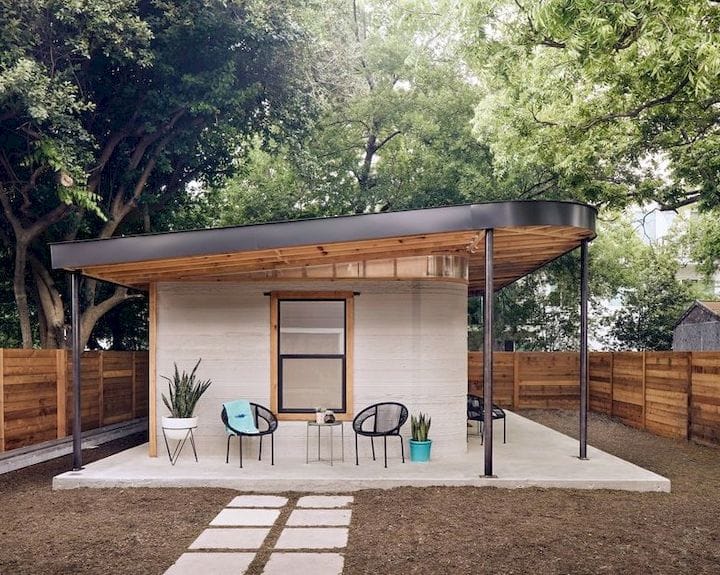![An partially 3D printed small home, allegedly built in 24 hours [Source; ICON]](https://fabbaloo.com/wp-content/uploads/2020/05/image-asset_img_5eb0a450ea59f.jpg)
ICON, an Austin, TX-based startup, has just raised a US$9M investment round.
The company, started in 2017, has the tagline “ICON is a construction technologies company dedicated to revolutionizing homebuilding”, and this involves 3D printing.
An article about the investment round on Venture Beat describes the intention of the company and the investment:
“Icon has raised $9 million in seed funding to build custom 3D-printed homes in less than 24 hours. In partnership with nonprofit New Story, the company wants to fight homelessness in the developing world.”
This video describes their project:
The investors providing the US$9M include a variety of Texas-oriented construction companies, and even one from the Gulf region, where there has been unnatural interest in 3D printed construction recently. They explain:
“We recently closed a $9M seed round led by Oakhouse Partners with additional investors including D.R. Horton, the largest homebuilder by volume in the U.S. since 2002; Emaar, the largest developer in the Middle East and creator of the tallest building in the world; Capital Factory, Texas’ premier start-up accelerator; CAZ Investments; Cielo Property Group; Engage Ventures; MicroVentures; Saturn Five; Shadow Ventures; Trust Ventures; Verbena Road Holdings and Vulcan Capital among others.”
How does their technology work? They have apparently developed a custom construction 3D printer that extrudes fat strands of mortar. They explain:
“The printer uses a proprietary small-aggregate cementitious material (also known as a mortar). Since the mix has relatively easy to find constituent parts, local procurement is expected to be feasible.
As much as we’d love to say we invented concrete…we did not. Concrete formulations from one to another can be as different as people. We did develop a proprietary formula that is unique for our current and future printing projects.”
The machine travels on rails of arbitrary length and has a 2D reach of 3.3m tall by 6.1m away. This provides a building envelope allowing the machine to build small, elongated concrete structures, such as their first experiment in Austin, where they evidently were able to gain an occupancy permit for the simple structure.
As long-time readers will recall, I am very skeptical of 3D printed house concepts, mainly due to the often outlandish claims by the builders. In the Venture Beat article, it says:
“… build custom 3D-printed homes in less than 24 hours …”
As is the customary claim by such ventures. The truth here is that no one has ever 3D printed a home in 24 hours. ICON themselves say that the Austin home was actually 3D printed in 48 hours, not 24, and that they are striving to reduce the time to 24 hours.
However, this is ONLY for the “printing” part of the construction. ICON says:
“The Vulcan I delivered a total print time of ~48 hours on our first house running at roughly 25% speed. We’re presently working on Vulcan II, which should be able to print a standard house in under 24 hours.”
And:
“The home serves as proof-of-concept and was created in partnership with the non-profit, New Story. New Story’s goal is to print a community of homes in an underserved population in 2019 with each home being around 600-800 square feet, printed for a cost ~$4,000 per home.”
There was no time estimate for electrical, plumbing, HVAC, windows, flooring, surface coverings, finishing, painting, inspections, and other disciplines that typically make up a normal construction project. This, like virtually all other construction 3D printing ventures, simply extrudes concrete walls.
![Inside the ICON 3D printed home. Note the open electrical circuits that were not placed within the 3D printed walls [Source: ICON]](https://fabbaloo.com/wp-content/uploads/2020/05/image-asset_img_5eb0a4515b791.jpg)
I think the US$4K price for the home is exclusive of all those other elements that are mandatory for a truly functional home. Expect the price to rise considerably.
Until someone invents a system that does ALL of those things, we do not have a 3D printed house, at any speed.
Yes, there are some advantages to 3D printing continuous walls, in that they then form a completely enclosed environment that might contain air leaks and thus be better for insulation. But there doesn’t seem to be any insulation in this project, aside from inefficient air gaps formed in the walls. Perhaps that’s suitable for hot developing regions where the target project is to take place, but it would not be suitable for almost any North American location.
Nevertheless, ICON has raised a considerable amount of money to develop the concept. I’m hoping the money spent on the developing country aids will have the side effect of ICON addressing aspects beyond the mere 3D printed walls, and thus working towards a truly 3D printed home.
Via Venture Beat and ICON











COBOD’s BOD2 construction 3D printer seems to be catching on as the company has made multiple sales of the new device.